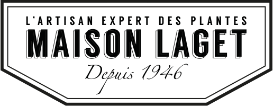HYDROLATES & FLORAL WATERS - GENERAL INFORMATION
The official pharmacopoeia definition of floral water only specifies that it is ‘obtained by the steam distillation of various parts of the aromatic plant or not’… and the word ‘floral’ refers only to the flower, whilst during distillation we sometimes we use other plant parts (leaves, twigs or whole plant ...).
For this reason, it is better to technically better to use the term ‘hydrolate’ rather than ‘floral water’ to designate the aqueous blend produced during the distillation process.
Identification & Origins
All our hydrosols are obtained from wild-harvested plants or organic farming.
MAISON LAGET is compliant with ECOCERT France standards thereby demonstrating its commitment to respect the organic production methods and processes, both in terms of cosmetic products and food quality products.
Knowledge and respect for the nature of hydrosols
MAISON LAGET maintains the same quality requirements for its hydrosols as it does for its essential oils, with systematic mention of the Latin name of the distilled vegetal matter and the Plant parts used (leaves, flowers, roots...).
How hydrosols are extracted
The term ‘floral water’ is a common generic name most often used to designate products with different compositions and distinct qualities.
Whole distillate. Water vapour passes through the plants during the distillation process, capturing the aromatic elements; it is then condensed through a coil bathed in cold water where it cools and becomes liquid, retaining the essential oil.
Hydrolate distillate (pure). The separation of the water vapour and the essential oil is done in the essencier. Once separated from its essential oil, it remains as a pure hydrosol that can be blended with water (distilled or not) which significantly reduces both the price and the quality.
Aromatic water (natural). Sometimes also called scented water, it results from a process where essential oil rather than plant material is placed in the still. Unfortunately, sometimes the essential oil is supplemented or replaced by synthetic ingredients and sometimes in both cases the scented material is mixed with water by simple agitation (natural or not). Whatever the chosen process, the result is unquestionably not a hydrolate!
Hydrosol. It is obtained by mixing a dozen drops of essential oils in 100 litres of water via a process that impregnates the water with essential oils. Although theoretically natural, hydrosols are not hydrolates !!
All of our floral waters are hydrolates elaborated on the basis of a 1:1 ratio (1 kg of fresh plant matter to obtain 1 kg of hydrolate), except for lime and blueberry floral waters whose essential oil is present in too small a quantity to be extracted and are actually whole distillates.
Traceability and Best Before Dates
We rigorously and systematically check each batch entering our workshop so as to accurately list the origins and characteristics of plant and packaging materials (bottles, caps...).
This 360 degree traceability is referenced by a batch number assigned to each product allowing the complete and precise identification of each component of the product. With this batch number, we are able to trace each component back to our different suppliers, who in turn can do the same throughout their own manufacturing circuits.
On each product, a Best Before Date informs you of the optimum and recommended lifespan of each product.
Manufacturing processes
All of MAISON LAGET’s hydrolates are obtained by slow steam distillation at low pressures according to traditional processes.
This traditional extraction process captures the aromatic substances through the use of water vapour at controlled pressures by rupturing the secretory cells ( essence pockets) of the plant containing the aromatic molecules.
Principles of steam distillation
The steam loaded with aromatic molecules then passes through a coil which is immersed in a cold water tank and becomes liquid (this is the ‘distillate’ commonly called floral water).
Essential oil is ultimately separated from the aqueous blend by its difference in density as essential oil is generally lighter than water. A small amount of essential oil remains as it is solubilised in the aqueous blend. This concentration varies according to the plant species, from trace elements ( i.e. Linden contains almost no essential oil) to 2 or more rarely 3 grams per litre.
This aqueous blend is the hydrolate, more commonly known as floral water.




